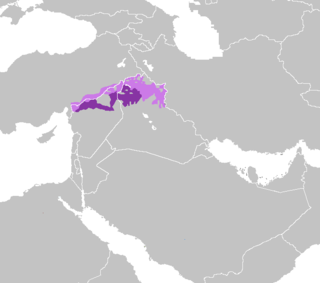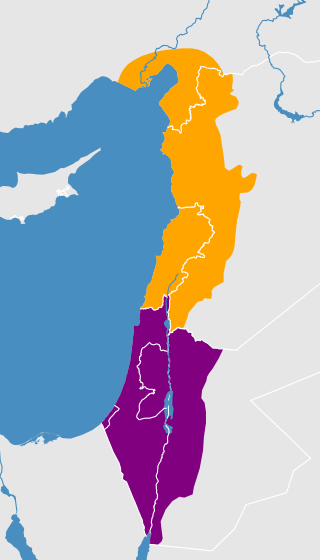Related Research Articles

Arabic is a Semitic language spoken primarily across the Arab world. Having emerged in the first millennium BC, it is named after the Arab people; the term "Arab" was initially used to describe those living in the Arabian Peninsula, as perceived by geographers from ancient Greece.

Turkmen, sometimes referred to as Turkmen Turkic or Turkmen Turkish, is a Turkic language of the Oghuz branch spoken by the Turkmens of Central Asia. It has an estimated 4.3 million native speakers in Turkmenistan, and a further 719,000 speakers in northeastern Iran and 1.5 million people in northwestern Afghanistan, where it has no official status. Turkmen is also spoken to lesser varying degrees in Turkmen communities of Uzbekistan and Tajikistan and by diaspora communities, primarily in Turkey and Russia.

Classical Arabic or Quranic Arabic is the standardized literary form of Arabic used from the 7th century and throughout the Middle Ages, most notably in Umayyad and Abbasid literary texts such as poetry, elevated prose and oratory, and is also the liturgical language of Islam. Classical Arabic is, furthermore, the register of the Arabic language on which Modern Standard Arabic is based.

Gulf Arabic is a variety of the Arabic language spoken in Eastern Arabia around the coasts of the Persian Gulf in Kuwait, Bahrain, Qatar, the United Arab Emirates, southern Iraq, eastern Saudi Arabia, northern Oman, and by some Iranian Arabs.

Sibawayh, whose full name is Abu Bishr Amr ibn Uthman ibn Qanbar al-Basri, was a Persian leading grammarian of Basra and author of the earliest book on Arabic grammar. His famous unnamed work, referred to as Al-Kitāb, or "The Book", is a five-volume seminal discussion of the Arabic language.

Cypriot Arabic, also known as Cypriot Maronite Arabic or Sanna is a moribund variety of Arabic spoken by the Maronite community of Cyprus. Formerly speakers were mostly situated in Kormakitis, but following the Turkish invasion of Cyprus in 1974, the majority relocated to the south and dispersed, leading to the decline of the language. Traditionally bilingual in Cypriot Greek, as of some time prior to 2000, all remaining speakers of Cypriot Arabic were over 30 years of age. A 2011 census reported that, of the 3,656 Maronite Cypriots in Republic of Cyprus-controlled areas, none declared Cypriot Arabic as their first language.
Ḍād (ﺽ), is one of the six letters the Arabic alphabet added to the twenty-two inherited from the Phoenician alphabet. In name and shape, it is a variant of ṣād. Its numerical value is 800.
Khorasani Turkic or Khorasani Turkish is an Oghuz Turkic language spoken in the North Khorasan Province and the Razavi Khorasan Province in Iran. Nearly all Khorasani Turkic speakers are also bilingual in Persian.

Arabic is the official language of Syria and is the most widely spoken language in the country. Several modern Arabic dialects are used in everyday life, most notably Levantine in the west and Mesopotamian in the northeast.
The Arabic language family is divided into several categories which are: Old Arabic, the literary varieties, and the modern vernaculars.

Central Asian Arabic or Jugari Arabic is a variety of Arabic currently facing extinction and spoken predominantly by Arab communities living in portions of Central Asia.
North Levantine Arabic was defined in the ISO 639-3 international standard for language codes as a distinct Arabic variety, under the apc code. It is also known as Syro-Lebanese Arabic, though that term is also used to mean all of Levantine Arabic.

North Mesopotamian Arabic, also known as Moslawi, Mesopotamian Qeltu Arabic, or Syro-Mesopotamian Arabic, is one of the two main varieties of Mesopotamian Arabic, together with Gilit Mesopotamian Arabic.

Ṣaʽīdi Arabic, or Upper Egyptian Arabic, is a variety of Arabic spoken by the Upper Egyptians in the area that is South/Upper Egypt, a strip of land on both sides of the Nile that extends from Aswan and downriver (northwards) to Lower Egypt. It shares linguistic features with Egyptian Arabic, Modern Standard Arabic, and the Classical Arabic of the Quran. Dialects include Middle and Upper Egyptian Arabic.

Jordanian Arabic is a dialect continuum of mutually intelligible varieties of Arabic spoken by the population of the Hashemite Kingdom of Jordan.

The Namara inscription is a 4th century inscription in the Arabic language, making it one of the earliest. It has also been interpreted as a late version of the Nabataean script in its transition to Arabic script. It has been described by Irfan Shahid as "the most important Arabic inscription of pre-Islamic times" and by Kees Versteegh as "the most famous Arabic inscription". It is also an important source for the relationships between the Romans and the Arabs in that period. It is currently on display at the Louvre Museum in France.
The Hilalian dialects are a continuum of Arabic dialects of the Maghreb, which were introduced during the Hilalian invasions between the 11th and 12th centuries, as well as the migration of Arab Hilalian tribes to the Western Maghreb. These dialects played a great role in the emergence of the Egyptian and Maghrebi dialects. The Bani Hilal tribes settled in the region of Casablanca-Settat in Morocco, parts of Libya, central Algeria, and Tunisia.
Pre-Hilalian dialects are a continuum of Arabic dialects native to North Africa. They constitute, along with the Hilalian dialects, the larger Maghrebi Arabic family.

Damascus Arabic or Damascus Dialect is a North Levantine Arabic spoken dialect, indigenous to and spoken primarily in Damascus. As the dialect of the capital city of Syria, and due to its use in the Syrian broadcast media, it is prestigious and widely recognized by speakers of other Syrian dialects, as well as in Lebanon, Palestine, and Jordan. Accordingly, in modern times it is sometimes known as Syrian Arabic or the Syrian Dialect; however, the former term may also be used to refer to the group of similar urban sedentary dialects of the Levant, or to mean Levantine Arabic in general.

Aleppo Arabic or Aleppine Arabic is the urban Arabic variety spoken in the city of Aleppo.
References
- ↑ Khorasani Arabic at Ethnologue (26th ed., 2023)

- ↑ Ulrich Seeger, On the Relationship of the Central Asian Arabic Dialects (translated from German to English by Sarah Dickins)
- ↑ Versteegh, Kees (2014-05-20). "The Arabic Language": 285. doi:10.1515/9780748645299.
{{cite journal}}: Cite journal requires|journal=(help)